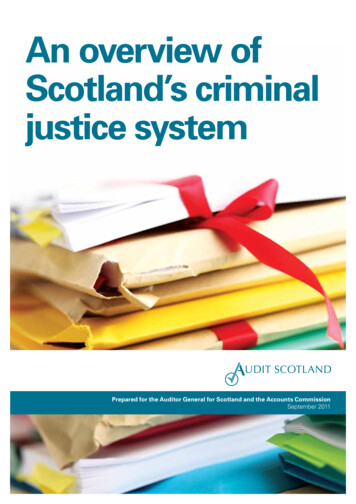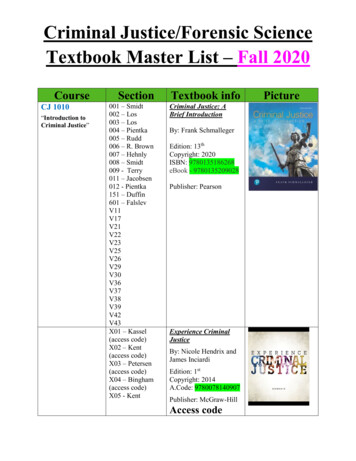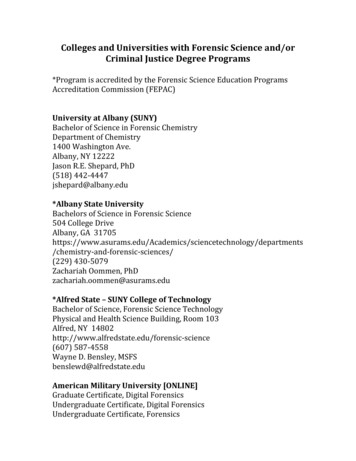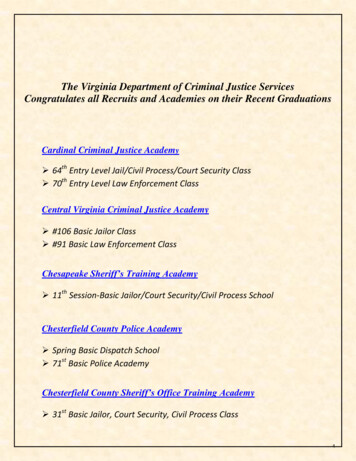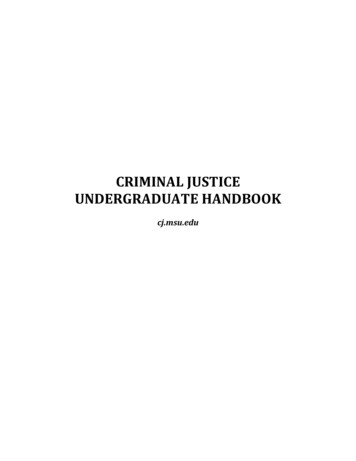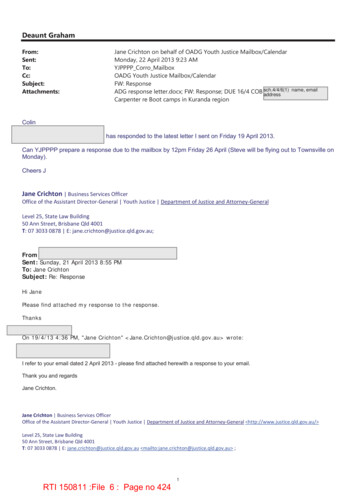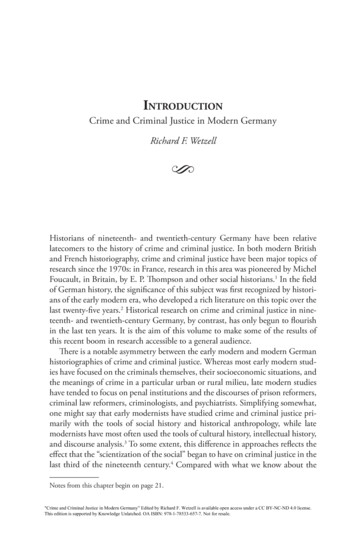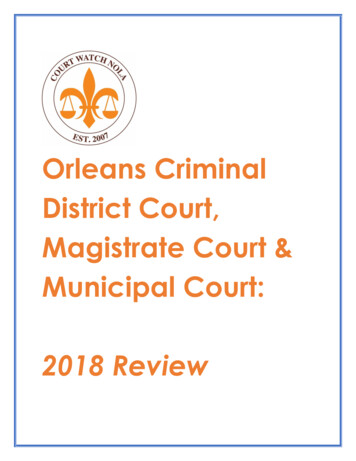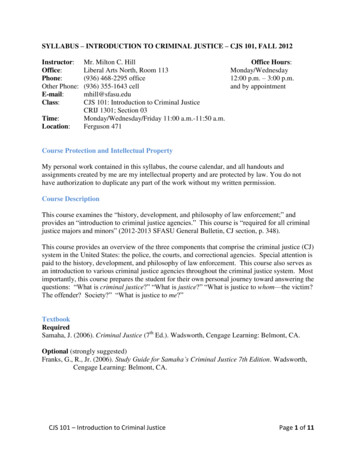
Transcription
SYLLABUS – INTRODUCTION TO CRIMINAL JUSTICE – CJS 101, FALL 2012Instructor:Office:Phone:Other Phone:E-mail:Class:Time:Location:Mr. Milton C. HillOffice Hours:Liberal Arts North, Room 113Monday/Wednesday(936) 468-2295 office12:00 p.m. – 3:00 p.m.(936) 355-1643 celland by appointmentmhill@sfasu.eduCJS 101: Introduction to Criminal JusticeCRIJ 1301; Section 03Monday/Wednesday/Friday 11:00 a.m.-11:50 a.m.Ferguson 471Course Protection and Intellectual PropertyMy personal work contained in this syllabus, the course calendar, and all handouts andassignments created by me are my intellectual property and are protected by law. You do nothave authorization to duplicate any part of the work without my written permission.Course DescriptionThis course examines the ―history, development, and philosophy of law enforcement;‖ andprovides an ―introduction to criminal justice agencies.‖ This course is ―required for all criminaljustice majors and minors‖ (2012-2013 SFASU General Bulletin, CJ section, p. 348).This course provides an overview of the three components that comprise the criminal justice (CJ)system in the United States: the police, the courts, and correctional agencies. Special attention ispaid to the history, development, and philosophy of law enforcement. This course also serves asan introduction to various criminal justice agencies throughout the criminal justice system. Mostimportantly, this course prepares the student for their own personal journey toward answering thequestions: ―What is criminal justice?‖ ―What is justice?‖ ―What is justice to whom—the victim?The offender? Society?‖ ―What is justice to me?‖TextbookRequiredSamaha, J. (2006). Criminal Justice (7th Ed.). Wadsworth, Cengage Learning: Belmont, CA.Optional (strongly suggested)Franks, G., R., Jr. (2006). Study Guide for Samaha’s Criminal Justice 7th Edition. Wadsworth,Cengage Learning: Belmont, CA.CJS 101 – Introduction to Criminal JusticePage 1 of 11
Course ObjectivesProgram Learning OutcomesThis course meets the following CJS Program objectives:1.The student will demonstrate an understanding of the three major components of the CJS,and the concepts of policing, corrections, courts, juvenile justice, probation and parole,and victimology.2.The student will demonstrate a fundamental understanding of human behavior from ahistorical, criminological and sociological perspective.1.2.3.4.5.Course-Specific Student Learning OutcomesThis course meets the following Course objectives:The student will be able to discuss the history, development, and current status of theAmerican criminal justice system.The student will be able to identify the role of the police, courts, and corrections in the―protection‖ of American society.The student will be able to explain the purpose and uses of alternate forms of―correction‖ such as parole and probation.The student will be able to identify various theories that offer possible explanations forcriminal behavior, recidivism, and desistance.The student will develop critical thinking and writing skills through essay responses onexaminations, QQTPs, and writing assignments.Assessment of Program Learning ObjectivesProgram Learning Objectives (PLOs) will be assessed through Pre- and Post-testing. Theassessment tool, a five question quiz, will collect student responses regarding the content of thePLOs listed above.General Student Learning ObjectivesReading - This class cannot be successfully completed without reading the required textbookchapters. Please pay special attention to bolded headings, words in italics, bullets, marginalnotes, illustrations, the chapter summary, and the list of key terms.Speaking - Students will be given the opportunity to present (and support) their opinions onvarious topics related to the course material.Computer Literacy - Students will be expected to utilize a word processing program, preferablyMicrosoft Word; will be able to send and receive communications by email; and will be able tonavigate Desire2Learn (D2L) for course information (https://d2l.sfasu.edu).Critical Thinking Skills - Understanding and functioning within the criminal justice system isnot a matter of just learning facts. The ability to think critically is essential. Stories and scenariospresented in class will address this skill and essay questions on exams will assess this skill.CJS 101 – Introduction to Criminal JusticePage 2 of 11
Attendance and PreparationBecause attendance and preparation are each weighted at 15% of the course grade, it is expectedthat students will regularly attend class, will refrain from being tardy, and will come to classprepared to discuss the scheduled topics. Attendance will be recorded by the taking of roll atsome point during each class. Class attendance requirements for this course are in accordancewith SFA‘s Class Attendance and Excused Absences Policy in the 2012-2013 General Bulletin(pp. 43-44).Preparation will be graded through the use of QQTPs. These brief papers are based upon thereading assignments for the particular class periods in which they are due. A handout about theQQTPs is provided during the first class meeting. Basically, the QQTP requires that you find: 1)an analytical question; 2) an interesting quotation; and 3) two ‗talking points‘ that you would beprepared to discuss in class from each assigned reading.AbsencesAttendance in this class is critical! Unexcused absences will affect your final grade according tothe following schedule:0-3 absences4-5 absences6-7 absences8-9 absences10 or more absences100 points earned (no penalty)75 points earned25 points earned0 points earned (loss of 15% of course grade)Failure of the courseParticipationBecause this class places a strong emphasis upon discussion, participation is essential.Participation will be graded by the instructor‘s observation of the student‘s involvement indiscussions, the student‘s general interest during class, and the student‘s inquisitiveness (askingquestions). NO ONE IS EXEMPT from participation, and the instructor‘s grading on this topic,though subjective, will be final.ExaminationsFour examinations will be given during the semester. The exams will cover only the materialstudied since the previous exam. The exams will have an objective section (multiple choice andtrue/false), and two subjective (short-answer and essay) sections. In the essay section, studentswill select a certain number of essay topics from those provided. Essay responses will be gradedupon content, critical thinking skills, and grammar.CJS 101 – Introduction to Criminal JusticePage 3 of 11
Bluebooks will not be required. Scantrons (Form 882) will be required, and they shall beprovided by the student. Additionally, although laptops have their utility, they will not bepermitted during examinations; all responses must be handwritten. Students must complete allfour exams for the semester.Please keep in mind that material from the textbook may not cover all of the requiredinformation; a portion of any examination material may come from other sources (as presentedor discussed in class).Make-Up ExamsStudents with legitimate reason and prior approval of the instructor can make up ONLY ONEexam at the end of the semester. Date and time will be announced—and that will be based uponthe instructor‘s schedule and convenience.GradingStudent grades will be earned according to the following table:90-100 DBelow 60%Below 420FThe cumulative semester grade will be based upon the following weights:Exam OneExam TwoExam ThreeFinal ExamAttendanceParticipationQQTPs(0-100 pts)(0-100 pts)(0-100 pts)(0-100 pts)(0-100 pts)(0-100 pts)(10 @ 0-10 pts; 100 pts possible)15%15%15%15%15%15%10%100% totalTentative Class SchedulePlease be advised that the class schedule on the following pages is a tentative schedule.We may spend more or less time on some topics than others.(Starts on next page)CJS 101 – Introduction to Criminal JusticePage 4 of 11
DAYDATEM8/27/2012W8/29/2012READING / PROJECTTOPICIntroductions & Syllabus ReviewExplanation of QQTPsOverview of D2L; Library; Student Servicespp. 3-15Criminal Justice in the United StatesCrime Control in a Constitutional DemocracyCriminal Justice Decision-makingF8/31/2012pp. 16 – 32Criminal Justice in the United States (cont.)Criminal Justice ModelsThe History of Crime Control and Due ProcessResearch and Criminal JusticeM9/3/2012W9/5/2012HOLIDAYLabor Day Holiday; No Classes MeetCrime, Criminals, and Victimspp. 36 - 53 / QQTP #1The Types of CrimeMeasuring CrimeTrends in CrimeF9/7/2012pp. 53-66Crime, Criminals, and Victims (cont.)CriminalsCrime VictimsM9/10/2012pp. 70-86Explanations of Criminal BehaviorClassical TheoriesBiological TheoriesW9/12/2012pp. 86-104 / QQTP #2Explanations of Criminal Behavior (cont.)Psychological TheoriesSociological TheoriesCriminal Law TheoriesF9/14/2012CJS 101 – Introduction to Criminal JusticeTo be determinedPage 5 of 11
DAYDATEM9/17/2012READING / PROJECTTOPICCriminal Justice and the Lawpp. 108-124Criminal LawW9/19/2012Criminal Justice and the Law (cont.)pp. 124-134The Law of Criminal ProcedureTo be determinedReview for exam #1F9/21/2012M9/24/2012Study for ExamW9/26/2012pp. 138-158Exam #1Missions and Roles of the PoliceThe History of Police and PolicingPolice Structure and OrganizationF9/28/2012Missions and Roles of the Police (cont.)pp. 158-183 / QQTP #3Police MissionsPolice OfficersM10/1/2012Policing Strategies186-193Patrol: The "Backbone" of PolicingCriminal InvestigationW10/3/2012Policing Strategies (cont.)pp. 193-218 /QQTP #4Proactive PolicingCommunity-Oriented (COP) and Problem-Oriented (POP)PolicingLaw Enforcement TechnologyF10/5/2012M10/8/2012To be determinedPolice and the Lawpp. 222-244 / QQTP #5Law Enforcement and the ConstitutionArrestSearchesInterrogationEyewitness Identification of StrangersCJS 101 – Introduction to Criminal JusticePage 6 of 11
DAYDATEREADING / PROJECTTOPICW10/10/2012pp. 244-266 / QQTP #6Police and the Law (cont.)Police Use of ForceRacial ProfilingPolice MisconductTo be determinedReview for exam #2F10/12/2012M10/15/2012Study for ExamW10/17/2012pp. 270-278Exam #2Courts and Courtroom Work GroupsThe Criminal Court StructureCriminal Court MissionsF10/19/2012pp. 278-293Courts and Courtroom Work Groups (cont.)The Courtroom Work GroupM10/22/2012Proceedings before Trialpp.296-315 / QQTP #7The Decision to ChargeThe First AppearanceW10/24/2012pp. 315-324Proceedings before Trial (cont.)Testing the Government's CaseArraignment and Pre-trial MotionsF10/26/2012M10/29/2012To be determinedpp. 328-338Conviction by Trial and Guilty PleaDisposition by TrialA Fair TrialW10/31/2012pp. 338-360 / QQTP #8Conviction by Trial and Guilty Plea (cont.)Disposition by NegotiationF11/2/2012M11/5/2012To be determinedpp. 364-371SentencingThe Purposes of SentencingThe History of SentencingCJS 101 – Introduction to Criminal JusticePage 7 of 11
DAYDATEW11/7/2012READING / PROJECTTOPICSentencing (cont.)pp. 371-386The Types of Determinate SentencingDisparity and Discrimination in SentencingF11/9/2012Sentencing (cont.)pp. 387-402 / QQTP #9The Death SentenceReview for exam #3M11/12/2012Study for ExamW11/14/2012pp. 406-420Exam #3Community CorrectionsProbation and ParoleF11/16/2012Community Corrections (cont.)pp. 420-434Intermediate PunishmentsM11/19/2012Prisons, Jails, and Prisonerspp. 438-449The History of U.S. PrisonsThe Prison Population BoomThe Side Effects of ImprisonmentW11/21/2012HOLIDAYThanksgiving Holiday; No Classes MeetF11/23/2012HOLIDAYThanksgiving Holiday; No Classes MeetM11/26/2012Prisons, Jails, and Prisoners (cont.)pp. 449-476PrisonsJailsPrisonersThe Length of ImprisonmentW11/28/2012pp. 480-506 / QQTP #10Prison LifeMale Prison SocietyLife in Women's PrisonsF11/30/2012Prison Life (cont.)pp. 507-526Law in Prison SocietyLeaving PrisonCJS 101 – Introduction to Criminal JusticePage 8 of 11
DAYDATEM12/3/2012READING / PROJECTpp. 530-551TOPICJuvenile JusticeThe History of Juvenile JusticeJuvenile Justice and the U.S. ConstitutionJuvenile DelinquencyW12/5/2012No ReadingF12/7/2012Study for Final ExamM12/10/201210:30 a.m. – 12:30 p.m.Review for Final ExamStudy Day - Meet in Study GroupsFinal Examination(Please see next page and following for additional, and very important, information)CJS 101 – Introduction to Criminal JusticePage 9 of 11
Acceptable Student BehaviorClassroom behavior should not interfere with the instructor‘s ability to conduct the class or theability of other students to learn from the instructional program (see the Student Conduct Code,policy D-34.1). Unacceptable or disruptive behavior will not be tolerated. Students who disruptthe learning environment may be asked to leave class and may be subject to judicial, academic orother penalties. This prohibition applies to all instructional forums, including electronic,classroom, labs, discussion groups, field trips, etc. The instructor shall have full discretion overwhat behavior is appropriate/ inappropriate in the classroom. Students who do not attend classregularly or who perform poorly on class projects/exams may be referred to the Early AlertProgram. This program provides students with recommendations for resources or otherassistance that is available to help SFA students succeed.Rules of the Classroom1.No cell phone usage this includes texting. You will be asked to leave – so don‘t do it.2.The wearing of hats, caps, or other head wear is not acceptable in the classroom.3.Maturity – Certain topics within this course may stir emotional reactions in some. So asnot to distract others or derail the lecture, mature behavior is required. Please treat otherswith respect and courtesy. If you distract my class—or if you disrespect others‘ opinions,feelings, or beliefs—you will be asked to leave.4.When others are speaking, you are expected to listen and to be respectful of the person‘sright to have an opinion that may differ from your own.5.I do not ―give‖ grades, I merely report them. You are in complete control of your finalgrade. Everyone starts with an A; where you go from there depends entirely upon you.Do NOT come to me at the end of the semester asking me to ―give‖ you anything.6.The tentative class schedule is a general guide. Coverage of the material may beaccelerated, decelerated, rearranged, augmented, diminished, or otherwise modified whenthe professor believes such change would be to the benefit of the class.7.This syllabus will act as the final word in the event of a discrepancy, error, ormisunderstanding. Make sure you read and understand it completely—and make sureyou keep a copy for reference during the semester.CJS 101 – Introduction to Criminal JusticePage 10 of 11
SFASU Policy StatementsAcademic IntegrityAcademic integrity is a responsibility of all university faculty and students. Faculty members promoteacademic integrity in multiple ways including instruction on the components of academic honesty, as wellas abiding by university policy on penalties for cheating and plagiarism.Definition of Academic Dishonesty: Academic dishonesty includes both cheating and plagiarism.Cheating includes but is not limited to (1) using or attempting to use unauthorized materials to aid inachieving a better grade on a component of a class; (2) the falsification or invention of any information,including citations, on an assigned exercise; and/or (3) helping or attempting to help another in an act ofcheating or plagiarism. Plagiarism is presenting the words or ideas of another person as if they were yourown. Examples of plagiarism are (1) submitting an assignment as if it were one's own work when, in fact,it is at least partly the work of another; (2) submitting a work that has been purchased or otherwiseobtained from an Internet source or another source; and (3) incorporating the words or ideas of an authorinto one's paper without giving the author due credit.Please read the complete policy at http://www.sfasu.edu/policies/academic integrity.aspAny occurrences of cheating or plagiarism will be dealt with according to University policy, provided toyou in your student handbook. (A‐9.1) Specifically, we will first meet together to discuss same in myoffice where you will be given the opportunity to explain your position. If it is determined that academicdishonesty has occurred, I will then make a decision as to the penalty therefore. Penalties may includereprimand or no credit for the assignment or exam, or re‐submission of the paper, or make‐up exam, orfailure of the course. I will then refer the incident to the Chair of the Department and the Dean of theCollege. This Report of Academic Dishonesty form, along with supporting documentation shall be madea part of the student‘s record and remains on file with the Dean‘s office for at least four (4) years. Asecond or subsequent offense shall be referred to the Committee on Academic Integrity pursuant topolicy.Students with DisabilitiesTo obtain disability related accommodations, alternate formats and/or auxiliary aids, students withdisabilities must contact the Office of Disability Services (ODS), Human Services Building, and Room325, 468-3004 / 468-1004 (TDD) as early as possible in the semester. Once verified, ODS will notify thecourse instructor and outline the accommodation and/or auxiliary aids to be provided. Failure to requestservices in a timely manner may delay your accommodations.For additional information, go to http://www.sfasu.edu/disabilityservices/Withheld grades Semester Grades Policy (A--‐54)Ordinarily, at the discretion of the instructor of record and with the approval of the academicchair/director, a grade of WH will be assigned only if the student cannot complete the course workbecause of unavoidable circumstances. Students must complete the work within one calendar year fromthe end of the semester in which they receive a WH, or the grade automatically becomes an F. If studentsregister for the same course in future terms the WH will automatically become an F and will be countedas a repeated course for the purpose of computing the grade point average.CJS 101 – Introduction to Criminal JusticePage 11 of 11
true/false), and two subjective (short-answer and essay) sections. In the essay section, students will select a certain number of essay topics from those provided. Essay responses will be graded upon content
